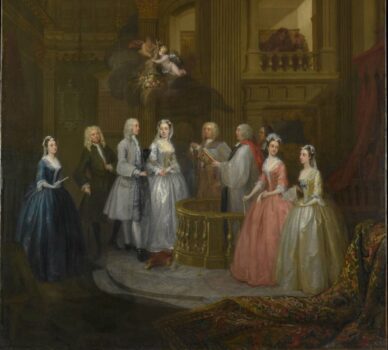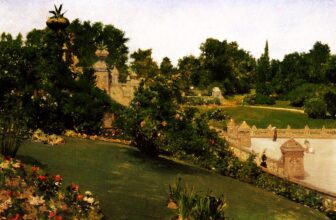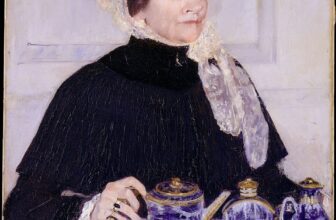Unveiling Hogarth’s The Wedding of Stephen Beckingham and Mary Cox
Perched elegantly in Gallery 630 of the Metropolitan Museum of Art, William Hogarth’s The Wedding of Stephen Beckingham and Mary Cox beautifully blends formal portraiture, social ceremony, and nuanced artistry. Painted in 1729, this oil-on-canvas work marks one of the artist’s early stagings of a “conversation piece”, a group portrait capturing personal connections and societal ritual.
What’s in the Painting?
At the center, the bride Mary Cox and groom Stephen Beckingham hold hands as a cleric conducts their marriage vows. Beckingham, then a barrister at Lincoln’s Inn, later became a justice of the peace; Cox was the daughter of a prosperous lawyer/businessman . Encircling them are solemn family members, fathers on either side, flanked by elegantly garbed female relatives, each arranged to underscore familial unity and status.
A pair of cherubic putti hovers above, descending on a somber-dark cloud, part blessing, part foreboding, suggesting layered symbolism in the moment’s celebration .
Why This Setting? Real or Ideal?
Although the marriage occurred at St. Benet’s Church near St. Paul’s Wharf, Hogarth adopted the newly consecrated interior of St. Martin‑in‑the‑Fields (Trafalgar Square) as the backdrop . This architectural choice, possibly assisted by someone with architectural painting skill, lends grandeur and formality, heightening the scene’s social resonance .
Such stylization signals that Hogarth’s intention was more about evoking the ceremony’s dignity than achieving documentary precision.
Hogarth’s Technique & Style
Measuring approximately 128 × 103 cm, Hogarth’s painting stands as a large-scale work, unusual in his otherwise satirical oeuvre.
While he meticulously portrays facial expressions with penetrating observation, evident in the corpulent, slightly satirical face of the rector, X‑radiographs reveal evidence of reworking: adjustments to foreground figures, cushions, and carpets. These retouches suggest sensitivity to patronal preferences and compositional balance .
Art as Conversation Piece
This painting aligns with the 18th-century genre of the “conversation piece”, intimate yet formal group portraits designed for display in private homes. Unlike his satirical scenes, Hogarth captures a sincere, solemn wedding moment, offering little sign of mockery.
Likely commissioned by a family patriarch, the piece functioned as a status symbol, celebrating union, lineage, and genteel taste.
Symbolism and Hidden Meanings of the Painting
Cherubic Blessings or Ominous Cloud?
Two infants cradle a floral garland over the couple. Though emblematic of innocence and blessing, the dark cloud beneath them hints at gravitational gravity, signaling life’s complexities even at its happiest moments .
Stole of Serenity vs. Satiric Undercurrents
The groom holds his bride’s hand firmly, emblematic of possession and protection, his gaze steady toward the minister. Meanwhile, the corpulent, serious-looking cleric may subtly channel Hogarth’s early satirical spirit.
Architecture & Attire as Status Markers
The grand church interior and detailed fashion, silken, fitted gowns; powdered wigs; tailored coats; luxe fabrics, project wealth and mid-class aspiration .
Rococo Roots & English Portraiture
While firmly part of English portrait tradition, the piece shows traces of Rococo influence in its ornamental sensibility: formal balance, refined elegance, and hinting grandeur . Yet Hogarth’s restraint on ornamentation keeps the focus on the people and the occasion.
Patronage and Professional Confidence
Painted approximately a decade before Hogarth gained fame for moralizing series like A Harlot’s Progress, this wedding commission reflects his developing portraiture skills . Though not the most fashionable portraitist of his day, his talents were recognized enough to earn such a poignant commission .
Where Is It Now & Viewing Insight
Donated to the Met’s collection in 1936 via the Marquand Fund, The Wedding of Stephen Beckingham and Mary Cox remains on view at Fifth Avenue, Gallery 630. Visitors have the rare chance to stand before an intimate 18th-century celebration rendered by a keen eye blending sincerity and subtle commentary.
Interpreting the Narrative Beyond the Surface
For contemporary viewers, Hogarth’s painting is more than historical documentation, it’s a visual narrative. The contrast between the poised family members and the uneasy undercurrents, the stern bridal father, composure of female relatives, and the subdued exception of the balcony children, suggests underlying social tensions, generational divides, or the formal structure of 18th-century family life.
The staging evokes both marital solemnity and private significance. Hogarth captures an ephemeral moment, half personal ritual, half social statement. The composition may also be read as a theatrical tableau: the “actors” posed before an “audience,” with their glances anchored in ritual engagement. The balcony children offer a counterpoint of innocence and youthful energy.
Hogarth’s Evolution: From Portraiture to Satire
This work marks a starting point on Hogarth’s artistic journey, from reserved portraitist to biting satirical commentator. As Elizabeth Einberg remarked, the subdued satirical trace, such as the clergyman’s corpulence, foreshadows the scathing moral series to come. The piece nestles in the transition between polite portraiture and moralizing art.
Persona & Setting: Stephen Beckingham and Mary Cox, a barrister and lawyer’s daughter, are depicted within a grand yet idealized church interior (based on St. Martin‑in‑the‑Fields).
Genre: A conversation piece, a large, formal group portrait reflecting social bonds.
Artistic Approach: Combines realistic likenesses, massed formality, subtle symbolism, and nuanced narrative detailing.
Symbolic Layers: Cherubs and dark sky, possessive posture, facial expressions and composition hint at solemnity and veiled tension.
Historical Context: 1729, precedes Hogarth’s moralizing print series; reflects evolving taste and artistic ambition.
Current Home: Metropolitan Museum of Art, New York, acquired via Marquand Fund in 1936, viewable in Gallery 630.
Why It Matters Today
This painting offers a vivid window into 18th-century ceremony: its elegance, social formality, and emotional undercurrent. It serves as evidence of Hogarth’s portraiture skill before moral critique became his hallmark, captured in sultry detail, charged composition, and intelligent staging. It exemplifies the conversation between personal celebration and societal expectation.
For modern audiences, The Wedding of Stephen Beckingham and Mary Cox resonates as both a charming wedding portrait and a meticulously constructed visual text, revealing history, emotion, artistry, and humanity.
Next time you wander Gallery 630, pause. Reflect on the poised couple and their silent attendants. Let Hogarth’s quiet drama spark your curiosity, about marriage rites, art history, social structures, and the timeless choreography of human ceremony.




